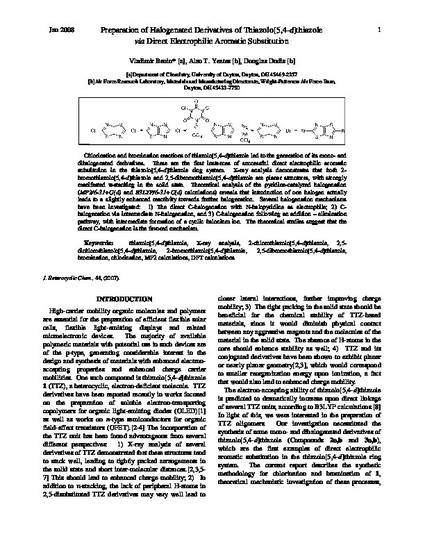
Chlorination and bromination reactions of thiazolo[5,4-d]thiazole led to the generation of its mono- and dihalogenated derivatives. These are the first instances of successful direct electrophilic aromatic substitution in the thiazolo[5,4-d]thiazole ring system. X-ray analysis demonstrates that both 2-bromothiazolo[5,4-d]-thiazole and 2,5-dibromothiazolo[5,4-d]thiazole are planar structures, with strongly manifested π-stacking in the solid state. Theoretical analysis of the pyridine-catalyzed halogenation (MP2/6-31+G(d) and B3LYP/6-31+G(d)calculations) reveals that introduction of one halogen actually leads to a slightly enhanced reactivity towards further halogenation. Several halogenation mechanisms have been investigated: 1) The direct C-halogenation with N-halopyridine as electrophile; 2) C-halogenation viaintermediate N-halogenation, and 3) C-halogenation following an addition - elimination pathway, with intermediate formation of a cyclic halonium ion. The theoretical studies suggest that the direct C-halogenation is the favored mechanism.
- Analytical Chemistry,
- Biochemical Phenomena, Metabolism, and Nutrition,
- Chemical and Pharmacologic Phenomena,
- Chemistry,
- Environmental Chemistry,
- Inorganic Chemistry,
- Materials Chemistry,
- Medical Biochemistry,
- Medicinal-Pharmaceutical Chemistry,
- Organic Chemistry,
- Other Chemistry and
- Physical Chemistry
Available at: http://works.bepress.com/vladimir_benin/2/

The document available for download is the authors' accepted manuscript, posted here in compliance with the publisher's policy on self-archiving.
Some differences may exist between this version and the publisher's version; as such, researchers wishing to quote directly from it are advised to consult the version of record, available at many libraries or from the publisher.
Permission documentation is on file.